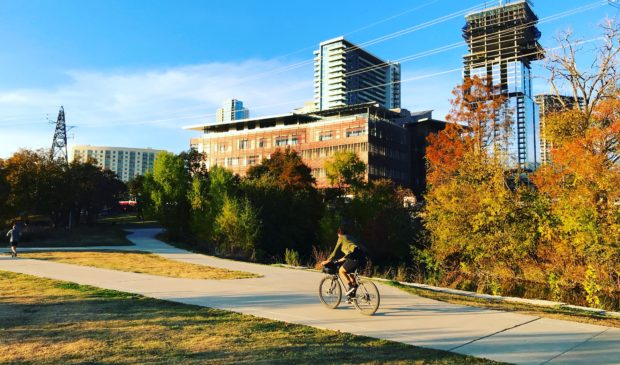Newsletter Signup
The Austin Monitor thanks its sponsors. Become one.
Most Popular Stories
- Latest State of Downtown report shows the city core’s businesses and housing are in transition
- Cap Metro to shelve 46 new electric buses for a year after manufacturer bankruptcy
- Jesús Garza disputes allegation that he violated city ethics rule
- Mobility Committee hears public concern regarding expansion of MoPac
- Council gives first reading OK to major development on tiny slice of land
-
Discover News By District

Prop B walks, rolls, rides to victory
Thursday, November 5, 2020 by Ryan Thornton
In addition to passing a historic mass public transit system under Proposition A, Austin voters also approved Prop B, a $460 million active mobility bond that will allow the city to make significant progress toward completing the bike lane network, filling missing sidewalk gaps and improving traffic safety.
In total, 260,706 votes were cast in favor of Prop B and 126,131 against. As a whole, only nine precincts – concentrated in West Austin – voted against the bond.
“Polling for the last two years has shown that Austinites throughout, not only in Travis County but those Austinites in Williamson County too, strongly favor having a choice, having mobility options,” Ted Siff of Austin Outside told the Austin Monitor on Tuesday night. “So to have safe sidewalks throughout the community, to have a bike network that is proposed in the bike plan that is now more than five years old, to have funding for those elements of the Austin Strategic Mobility Plan is simply a logical implementation of that plan that was unanimously passed by (City Council) 18 months ago.”
The mobility bond includes $80 million for sidewalk construction and repairs, $120 million for urban trails and bikeways, $64 million for Vision Zero and safety projects, $20 million for the Safe Routes to School program, $19 million for transit enhancements, $1 million for the Neighborhood Partnering Program, $102 million for large capital projects, and $53 million for improvements to substandard streets.
Austin Outside, a coalition of local mobility advocates, had initially called for a $750 million bond this year – the estimated amount needed to complete the high- and very-high-priority projects identified in the city’s bicycle, urban trail and sidewalk plans. A separate grassroots plan, known as the Wheel Deal, had called for a $350 million investment in bikeways and urban trails and another $350 million in sidewalks. City Council considered both proposals too steep, especially in a year when many residents are suffering economic hardship.
As a compromise, Council Member Paige Ellis proposed a $450 million plan, sufficient to complete 80 percent of the city’s bike lane network, repair and build around 100 miles of sidewalks, boost the Vision Zero program, create safe routes to school, improve substandard streets in the eastern crescent, and provide funding for capital mobility projects like a new bicycle and pedestrian bridge adjacent to Longhorn Dam.
Although Council Member Ann Kitchen attempted to further decrease the bond amount to $300 million, Council ultimately tacked another $10 million onto Ellis’ proposal for the ballot.
With between $300 million and $350 million of the approved bond dollars to be used for active transportation facilities, Siff said the vote is a “substantial down payment” on the city’s mobility goals, such as drastically reducing the share of commutes made by car down to 50 percent in the coming two decades. Siff added, “I think we’ll have all this money spent within this decade, and if we do that, Austin will be in a different league in terms of cities that have robust mobility choices for all of its citizens.”
The mobility bond is a six-year program, with the first bonds likely to be issued in September of next year. The funds would allow the city to carry forward its mobility infrastructure work as the remainder of the $720 million 2016 mobility bond dollars are being expended over the next couple of years. However, this bond is not simply a renewal or repeat of the 2016 bond, which directed the majority of its funds into the corridor mobility program. In all, the 2016 bond set aside a total of $137 million to be used specifically for local mobility projects like sidewalks, bikeways, urban trails, Vision Zero and Safe Routes to School.
Photo made available through a Creative Commons license.
The Austin Monitor’s work is made possible by donations from the community. Though our reporting covers donors from time to time, we are careful to keep business and editorial efforts separate while maintaining transparency. A complete list of donors is available here, and our code of ethics is explained here.
You're a community leader
And we’re honored you look to us for serious, in-depth news. You know a strong community needs local and dedicated watchdog reporting. We’re here for you and that won’t change. Now will you take the powerful next step and support our nonprofit news organization?








